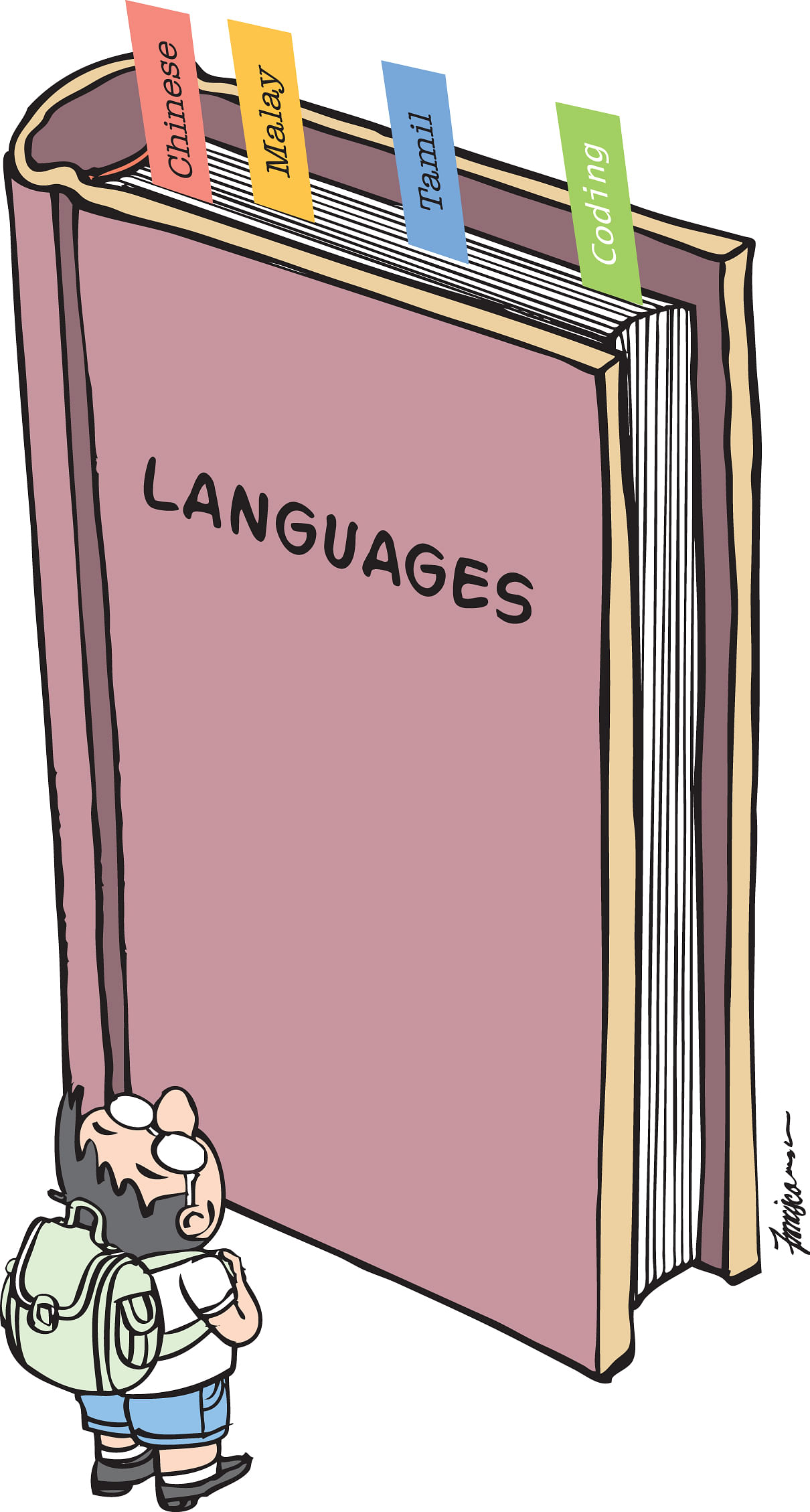Adora Lian, 13, likes Jay Chou's pop music and classical pieces such as those composed by Ludwig van Beethoven.
But she is not allowed to use her mobile phone in school, so she can't listen to music. The frustrated music lover, a Secondary 1 student from Xinmin Secondary School, tinkered with crocodile clips, a mini speaker and a pocket-size, codeable computer called the micro:bit.
After some 20 hours of coding lessons facilitated by her school and 10 hours of actual coding last month, she created a music player.
"Now, I can listen to music whenever I want to," said Adora. Her "player" now carries just two tunes, but she plans to add more songs and increase the volume of the speaker.
Singapore wants to groom more Adoras - students comfortable with technology and making things work by tinkering with computer codes or components - as part of a plan to instil digital literacy in students.
Last month, Communications and Information Minister Yaacob Ibrahim announced a $3 million plan, dubbed the Digital Maker Programme, that aims to distribute 100,000 micro:bits to schoolgoing children and adults over the next two years to teach basic coding.
Xinmin Secondary School was trialling the device as an early adopter.

Dr Yaacob said: "Who knows, one day we may be nurturing Singapore's own generation of Steve Jobs." He noted that Singaporeans need a curious mind and the passion to create things with their hands to be better prepared for the digital future.
CODING A CRUCIAL FUTURE LANGUAGE
Coding - or digital competence - is essential for the future.
Ms Ayesha Khanna, chief executive officer of data science and artificial intelligence firm Addo, explained: "The use of technology will underpin the development of every single industry: banking, transport, telecoms and so on."
That is why she set up 21C Girls, a charity that teaches coding to girls. She added: "Children must feel comfortable partnering technology to solve real-world problems of tomorrow."
Today's world is highly connected and digital.
Citizens interact using smartphones and social media platforms. They use e-wallets for payments. Deliveries are announced via app alerts or SMS, and picked up from digitally controlled lockers. In industry, Airbnb offers accommodation worldwide without owning hotel rooms. Uber offers paid rides without owning cars. They can do so with technology that matches asset owners with users.
In the industrialised economy, children needed basic literacy and numeracy to function in society and work in factories.
Some experts say that in a digital economy, it isn't just computer scientists or website designers who need to know coding. Every child needs to understand it.
Mr Hank Pellissier, a writer on education issues, suggested in an article on www.greatschools.org that schools promote coding as a "second language" the way they promote Spanish or Chinese.
He wrote: "Even knowing just a little coding can help reduce the fear of technology, opening a mental window to understanding and using tech skills more broadly. There's also the argument, propounded by Steve Jobs himself, that coding 'teaches you how to think'. Many educators say coding can provide children with brain gains in information processing, logic, problem solving, experimentation and creativity."
Enter the micro:bit.
This system, developed by Britain-based Farnell element14, contains a programmable array of LED lights, sensors, a Bluetooth chip and an accelerometer.
Singapore has chosen to use the micro:bit. It joins Britain, the United States, Canada, Belgium and Denmark in doing so. As more countries use it for their students, more third-party apps for the micro:bit are coming on board.
The system is cheap - $30 a unit, and flexible. You can turn the micro:bit into a step-counter as an in-built motion sensor detects and logs the number of steps you take in a day. Or it can become a locator tool by detecting the presence of another micro:bit tagged to one's belongings.
Users write code on a website, and then transfer the code to the micro:bit with either a USB cable or a Bluetooth connection.
Mr Khoong Hock Yun, assistant chief executive of the Infocomm Media Development Authority of Singapore (IMDA), said the use of the micro:bit is also strategic.
"We are trying to build the capacity to adapt to future digital disruptions and the creative confidence to find answers," he said.
To be sure, the micro:bit is not the first programme to roll out coding to students. The IMDA has worked with the Ministry of Education (MOE) since June 2015 to conduct its Code for Fun enrichment programme in schools. It uses basic robotic kits such as Lego Wedo and MoWay, and more complex microcontrollers such as Arduino. To date, 128 out of more than 300 primary and secondary schools are on board, and some 56,000 students have been trained.
In January, Google rolled out a Code in the Community programme, subsidising the cost of coding lessons - estimated to be worth at least $1 million - to teach some 3,000 children from needy homes how to code over the next three years.
COMPULSORY CODING?
In Britain, national broadcaster BBC started distributing the micro:bit in March last year to 11- and 12-year-old children. The plan is to distribute one million devices to schools to help teach coding and inspire interest in Stem (science, technology, engineering and mathematics) subjects.
More importantly, a coding curriculum has been mandatory in all British primary and secondary schools since September 2014.
In Singapore, coding is an enrichment programme in schools, like music and ballet. Computing will be offered as an O-level subject at Secondary 3, starting in 19 schools this year.
If digital literacy could be as important as reading and writing, should coding be part of the school curriculum in Singapore?
There are practical difficulties to such an approach. Cramming another compulsory subject into a crowded school curriculum will be tough and stressful for students and teachers.
Also, as Associate Professor Ben Leong from the National University of Singapore's School of Computing said, it is hard to find enough qualified teachers so quickly.
He has trained more than 40 secondary school teachers in Python, a computing language, as its chief instructor. This year, he will be training 20 more junior college teachers to teach Python. Most teachers do not have a coding background, which makes it harder for them to pick up the skill.
There is a middle way: In another digitally advanced nation, Estonia, coding is not compulsory, but lessons were rolled out in kindergartens and schools in 2012.
Estonia requires all primary school teachers to integrate technology in the subjects that they teach. They can use the Scratch programming language to teach mathematics or teach children to compose music during music lessons.
That's something Singapore too can pick up.
Lecturer David Chin, 46, a father of three children aged 11, 12 and 14, suggested incorporating coding into existing subjects like maths and science at all levels.
For instance, a project to program a robot to navigate a maze or move around objects requires the student to calculate distance, speed, direction and angles - all maths concepts.
What are MOE's plans to formally include coding in the school curriculum?
Responding to this question, MOE referred to existing enrichment programmes and co-curricular activities in infocomm clubs or the Stem Applied Learning Programme that teach coding. It said those with a passion for computing can take the subject at the O- or A-level stage.
It added: "Beyond coding, there is a larger set of computational thinking skills that are useful for our students. These skills are also learnt in subjects like mathematics which require students to think logically and solve problems systematically."
Meanwhile, the IMDA hopes that demand from the ground will hasten the acceptance of its coding programmes.
Xinmin Secondary School teacher Tai Hui Gyan, 46, said her students not only enjoyed tinkering with the micro:bit, but were able to address real-world needs: One student programmed the micro:bit to play an alert after every six hours or 12 hours to remind the elderly to take their medication.
The bottom line? If coding is the language of the future, the answer to whether it should be taught in all schools is obvious. As with all things, the devil is in the details.
Singapore can go the British way and make it compulsory. Or it can do it the Estonia way, and work it into the syllabus at the primary school level.
As disruption takes place at breakneck speed, there is no better time to decide and start than now.

